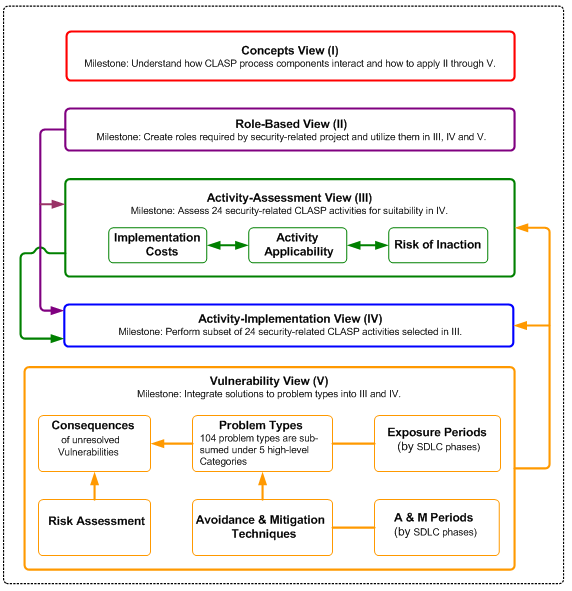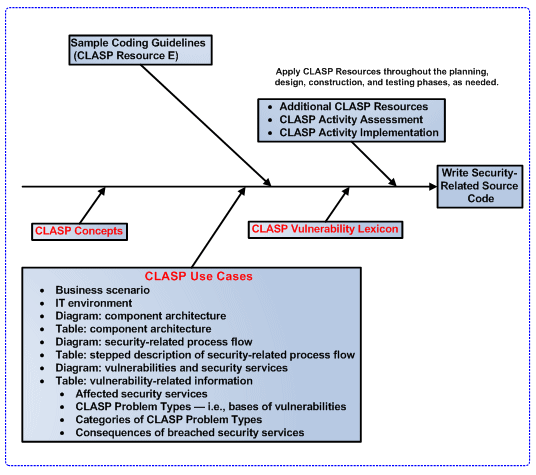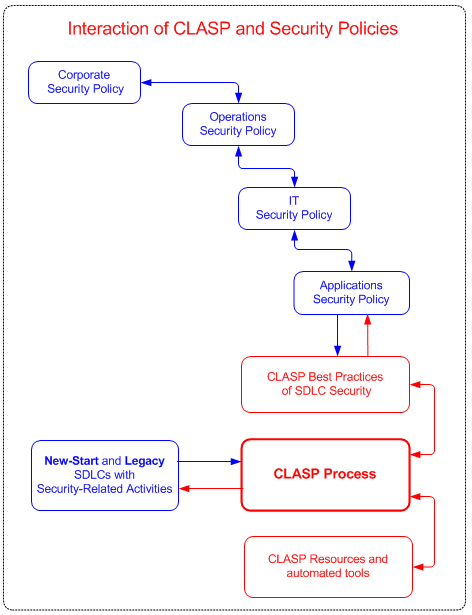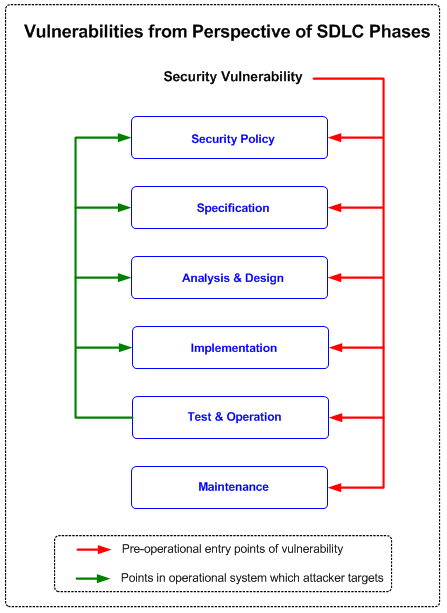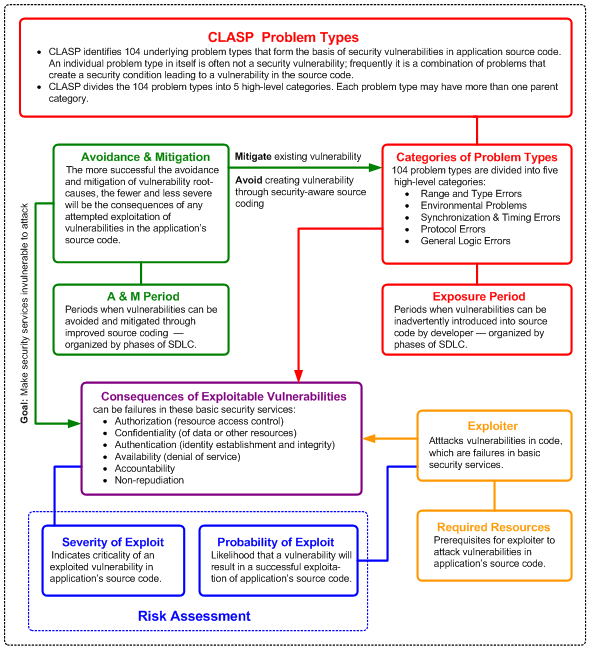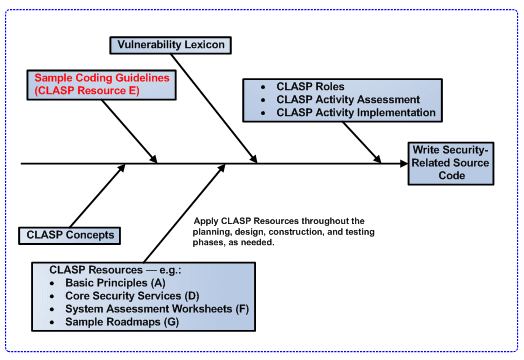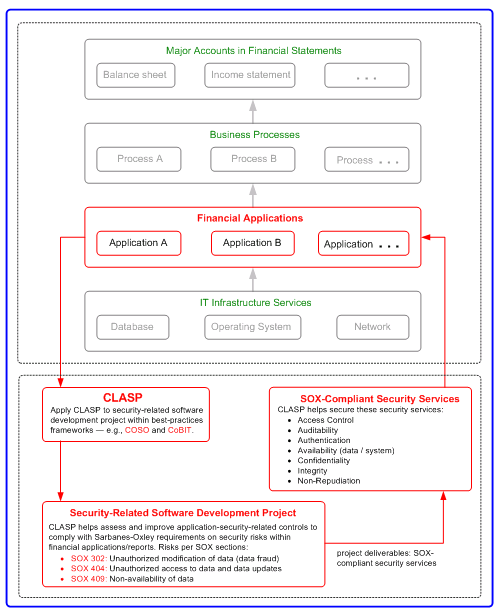This site is the archived OWASP Foundation Wiki and is no longer accepting Account Requests.
To view the new OWASP Foundation website, please visit https://owasp.org
CLASP Concepts
This page contains content that is outdated and is no longer being maintained. It is provided as a courtesy for individuals who are still using these technologies. This page may contain URLs that were once valid but may now link to sites or pages that no longer exist.
Please use the newer Edition(s) like OWASP_SAMM_Project
Concepts View
CLASP is the outgrowth of years of extensive field work in which system resources of many development lifecycles were methodically decomposed in order to create a comprehensive set of security requirements. These resulting requirements form the basis of CLASP’s best practices which allow organizations to systematically address vulnerabilities that, if exploited, can result in the failure of basic security services — e.g., confidentiality, authentication, and access control.
Adaptability of CLASP to Existing Development Processes
CLASP is designed to allow you to easily integrate its security-related activities into your existing application development processes. Each CLASP activity is divided into discrete process components and linked to one or more specific project roles. In this way, CLASP provides guidance to project participants — e.g., project managers, security auditors, developers, architects, testers, and others — that is easy to adopt to their way of working; this results in incremental improvements to security that are easily achievable, repeatable, and measurable.
CLASP Vulnerability Lexicon
CLASP also contains a comprehensive Vulnerability Lexicon that helps development teams avoid/remediate specific designing/coding errors that can lead to exploitable security services. The basis of this Lexicon is a highly flexible taxonomy — i.e., classification structure — that enables development teams to quickly locate Lexicon information from many perspectives: e.g., problem types (i.e., basic causes of vulnerabilities); categories of problem types; exposure periods; avoidance and mitigation periods; consequences of exploited vulnerabilities; affected platforms and programming languages; risk assessment.
Automated Analysis Tool
Much of the information in the CLASP Vulnerability Lexicon can be enforced through use of automated tools using techniques of static analysis of source code.
Overview of CLASP Process
This section provides an overview of CLASP’s structure and of the dependencies between the CLASP process components and is organized as follows:
- CLASP Views
- CLASP Resources
- Vulnerability Use Cases
CLASP Views
The CLASP process is presented through five high-level perspectives called CLASP Views. These views are broken down into activities which in turn contain process components. This top-down organization by View > Activity > Process Component allows you to quickly understand the CLASP process, how CLASP pieces interact, and how to apply them to your specific software development lifecycle. These are the CLASP Views:
- Concepts View
- Role-Based View
- Activity-Assessment View
- Activity-Implementation View
- Vulnerability View
See figure 1.
CLASP Resources
The CLASP process supports planning, implementing and performing security-related software development activities. The CLASP Resources provide access to artifacts that are especially useful if your project is using tools to help automate CLASP process pieces. This table lists the name and location of CLASP Resources delivered with CLASP and indicates which CLASP Views they can support:
| CLASP Resources | Location |
|---|---|
| Basic Principles in Application Security (all Views) | Resource A |
| Example of Basic Principle: Input Validation (all Views) | Resource B |
| Example of Basic-Principle Violation: Penetrate-and-Patch Model (all Views) | Resource C |
| Core Security Services (all Views; especially III) | Resource D |
| Sample Coding Guideline Worksheets (Views II, III & IV)
Note: Each worksheet can be pasted into a MS Word document. |
Resource E |
| System Assessment Worksheets (Views III & IV)
Note: Each worksheet can be pasted into a MS Word document. |
Resource F |
| Sample Road Map: Legacy Projects (View III) | Resource G1 |
| Sample Road Map: New-Start Projects (View III) | Resource G2 |
| Creating the Process Engineering Plan (View III) | Resource H |
| Forming the Process Engineering Team (View III) | Resource I |
| Glossary of Security Terms (all Views) | Resource J |
Vulnerability Use Cases
The CLASP Vulnerability Use Cases depict conditions under which security services can become vulnerable in software applications. The Use Cases provide CLASP users with easy-to-understand, specific examples of the cause-and-effect relationship between security-unaware design/source coding and possible resulting vulnerabilities in basic security services — e.g., authentication authorization, confidentiality, availability, accountability, and non-repudiation. The CLASP Vulnerability Use Cases are based on the following common component architectures:
- Monolithic UNIX
- Monolithic mainframe
- Distributed architecture (HTTP[S] & TCP/IP)
It is recommended to understand the CLASP Use Cases as a bridge from the Concepts View of CLASP to the Vulnerability Lexicon (in the Vulnerability View) since they provide specific examples of security services becoming vulnerable in software applications See figure 2.
CLASP Best Practices
The foundation of CLASP is in seven key Best Practices for application security. See CLASP Best Practices.
- Institute awareness programs
- Perform application assessments
- Capture security requirements
- Implement secure development practices
- Build vulnerability remediation procedures
- Define and monitor metrics
- Publish operational security guidelines
CLASP and Security Policies
A high-level view of CLASP can help increase awareness of the importance of implementing application security on these organizational levels, from the bottom up: > best practices of application-security > application-security policy > IT security policy > operations security policy > corporate security policy.
What is a Security Vulnerability
CLASP defines a security vulnerability as a flaw in a software environment — especially in an application — that allows an attacker to assume privileges within the user's system, utilize and regulate its operation, compromise the data it contains, and/or assume trust not granted to the attacker. A security vulnerability occurs in a software application when any part of it allows a breach of the security policy governing it. CLASP identifies 104 underlying problem types that form the basis of security vulnerabilities in application source code. An individual problem type in itself is often not a security vulnerability; frequently it is a combination of problems that create a security condition leading to a vulnerability in the source code. CLASP divides the 104 problem types into 5 high-level categories. Each problem type may have more than one parent category. CLASP defines a consequence of an exploited or exploitable vulnerability as a failure in one or more of these basic security services:
- Authorization (resource access control)
- Confidentiality (of data or other resources)
- Authentication (identity establishment and integrity)
- Availability (denial of service)
- Accountability
- Non-repudiation
The following figure shows in which phases of the software development lifecycle a security-related vulnerability can occur and also which points in an operational system an attack can target.
Overview of CLASP Taxonomy
The CLASP taxonomy is a high-level classification of the CLASP process, divided into the following classes for better evaluation and resolution of security vulnerabilities in source code:
- Problem types underlying security-related vulnerabilities.
- Categories into which the problem types are divided for diagnostic and resolution purposes.
- Exposure periods (i.e., SDLC phases) in which vulnerabilities can be inadvertently introduced into application source code.
- Consequences of exploited vulnerabilities for basic security services.
- Platforms and programming languages which may be affected by a vulnerability.
- Resources required for attack against vulnerabilities.
- Risk assessment of exploitable/exploited vulnerabilities.
- Avoidance and mitigation periods (i.e., SDLC phases) in which preventative measures and countermeasures can be applied.
See figure 6.
Applying CLASP Components
This page describes a possible sequence for applying CLASP components, using the Sample Coding Guidelines (CLASP Resource E) as a basis. See figure 7.
The steps below describe a possible sequence for applying CLASP components depicted in the figure above:
- Read the CLASP Concepts View to gain an overview of the CLASP process.
- In the Concepts View, pay special attention to the page Description of CLASP Process. This page contains a diagram showing, among other things, the location of the 104 CLASP problem types (i.e., basic causes of vulnerabilities), the five high-level, source-code-related categories by which they are organized, and the consequences of exploitable security vulnerabilities for security services.
- Read the CLASP Sample Coding Guidelines thoroughly and select a subset of them relevant to your specific software development project. These guidelines contain a set of security-related coding standards to be applied to your project.
- Apply the remaining CLASP Resources throughout the planning, design, construction, and testing process, as needed.
- Use the Sample Coding Guidelines to select a subset of the 104 CLASP problem types (i.e., basic causes of vulnerabilities) — located in the CLASP Vulnerability View — which are most important to your project.
- Familiarize yourself with the CLASP Role-Based View, which provides an overview of the project roles associated with applying the selected subset of Sample Coding Guidelines, and assign these guidelines to your relevant project personnel — e.g., designer, security auditor, implementers.
- Consider the subset of vulnerabilities selected in part though the Sample Coding Guidelines when using the Activity-Assessment View to assess and select the desired subset of 24 activities contained in the Activity-Implementation View.
CLASP and IT Internal Controls
A significant number of the internal controls required by the Sarbanes-Oxley Act for assurance of accurate and reliable corporate financial reporting are located in the IT area. The figure below shows how CLASP can help secure the IT internal controls that are necessary to assure the integrity of data in financial applications within the scope of security-related software development projects.
